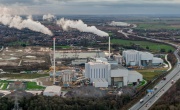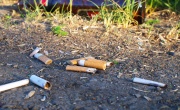Household waste in Scotland reduced by one per cent in 2023
Latest figures from SEPA also show household recycling rates marginally improved to 43.5 per cent, with rates yet to return to pre-pandemic levels.
 The Scottish Environment Protection Agency (SEPA) have published official statistics detailing household waste collected across Scotland’s Local Authorities in 2023, including recycling, landfill, and incineration data.
The Scottish Environment Protection Agency (SEPA) have published official statistics detailing household waste collected across Scotland’s Local Authorities in 2023, including recycling, landfill, and incineration data.
The 2023 figures reveal that household waste dropped by 26,000 tonnes (1.1 per cent) since 2022.
The reduction comes alongside a slight increase in the overall household recycling rate, which reached 43.5 per cent in 2023. Whilst this figure comes as an increase from the 2022 rate of 43.3 per cent, the rates have yet to return to the high of 45.6 per cent in 2017, before the Covid-19 pandemic.
As shown in Table 1, the highest recycling rate was 58.2 per cent in East Renfrewshire, with the lowest rates coming from the Shetland and Orkney Islands.
| Local authority | Generated (tonnes) | Recycled (tonnes) | Recycled (tonnes per person) | Recycled (%) | Carbon impact (tCO2e) | 2022 Recycled (%) |
|---|---|---|---|---|---|---|
| East Renfrewshire | 37863 | 22030 | 0.228 | 58.2 | 71655 | 56 |
| Scottish Borders | 51930 | 30050 | 0.257 | 57.9 | 116984 | 57.3 |
| North Ayrshire | 58888 | 33037 | 0.248 | 56.1 | 117500 | 55.3 |
| Moray | 42712 | 23583 | 0.252 | 55.2 | 81624 | 57.8 |
| South Ayrshire | 48398 | 26489 | 0.237 | 54.7 | 97602 | 54.3 |
| East Lothian | 48969 | 25979 | 0.231 | 53.1 | 101565 | 53.1 |
| Angus | 50083 | 26077 | 0.228 | 52.1 | 98029 | 51.7 |
| Clackmannanshire | 23649 | 12303 | 0.238 | 52 | 52709 | 51.2 |
| Perth and Kinross | 71456 | 36939 | 0.245 | 51.7 | 135557 | 49.3 |
| Stirling | 40982 | 21146 | 0.228 | 51.6 | 87548 | 51.4 |
| West Lothian | 78949 | 40125 | 0.221 | 50.8 | 158235 | 45.9 |
| Falkirk | 60499 | 30654 | 0.194 | 50.7 | 141375 | 51.4 |
| East Ayrshire | 50677 | 25459 | 0.212 | 50.2 | 103573 | 48.5 |
| Inverclyde | 24544 | 11519 | 0.147 | 46.9 | 57018 | 46.8 |
| Midlothian | 41335 | 19388 | 0.201 | 46.9 | 96704 | 47.2 |
| North Lanarkshire | 146830 | 68534 | 0.201 | 46.7 | 328118 | 43 |
| East Dunbartonshire | 52230 | 24001 | 0.22 | 46 | 117103 | 48.6 |
| Fife | 168100 | 77115 | 0.208 | 45.9 | 371683 | 45.7 |
| Renfrewshire | 74604 | 32846 | 0.179 | 44 | 163908 | 53.7 |
| Aberdeenshire | 111653 | 48040 | 0.182 | 43 | 282667 | 40.2 |
| Aberdeen City | 89314 | 37314 | 0.167 | 41.8 | 219570 | 41.8 |
| Dumfries and Galloway | 63110 | 26000 | 0.178 | 41.2 | 150485 | 45.1 |
| South Lanarkshire | 149096 | 61134 | 0.187 | 41 | 347118 | 41.1 |
| Argyll and Bute | 49688 | 20228 | 0.235 | 40.7 | 118612 | 40.8 |
| City of Edinburgh | 191709 | 72846 | 0.142 | 38 | 468805 | 37.1 |
| Dundee City | 61396 | 22456 | 0.152 | 36.6 | 138834 | 35.6 |
| West Dunbartonshire | 38544 | 13957 | 0.158 | 36.2 | 99546 | 38.8 |
| Highland | 111532 | 40124 | 0.17 | 36 | 284995 | 37.2 |
| Na h-Eileanan Siar | 12572 | 4416 | 0.169 | 35.1 | 33300 | 31.8 |
| Glasgow City | 235159 | 63989 | 0.103 | 27.2 | 655546 | 27.6 |
| Orkney Islands | 9475 | 2029 | 0.092 | 21.4 | 24283 | 23.3 |
| Shetland Islands | 8899 | 1840 | 0.08 | 20.7 | 26896 | 20.7 |
Table 1: Scottish household waste generated and managed in 2023
The largest change in materials recycling rates came from paper and cardboard, which saw a decrease of 9,900 tonnes (5.4 per cent). This comes as part of a long term downward trend of paper and cardboard recycling, which can partially be attributed to the move away from print media.
Organic waste treatment at a composting plant or anaerobic digestion facility also increased by 7,600 tonnes (2.1 per cent) to 362,000 tonnes in 2023.
Commenting on the release of the data, Jo Zwitserlood, Head of Energy, Industry and Materials at SEPA, said: "We’ve all got a role to play – the consumption of products and use of materials touches on every one of us. We’re making positive steps towards lowering the carbon impact of Scotland’s household waste and seeing lower amounts of waste generated and disposed of to landfill, which is key to addressing the environmental impact of waste management.”
Iain Gulland, Chief Executive at Zero Waste Scotland, added: “When we all work together we can make a real difference, so it’s extremely welcome to see the efforts of people at home reflected in SEPA’s latest data – with household waste at its lowest level in over a decade and recycling rates continuing to climb.”
The data highlighted a reduction in the carbon footprint of Scotland’s household waste to under one tonne of carbon dioxide equivalent (CO2e) per person, which decreased by 3.2 per cent from 2022. SEPA suggested that this is largely due to the increased recycling rates, particularly for materials such as non ferrous metallic wastes and glass wastes.
Landfill waste also decreased by 14.8 per cent from 2022. Household waste saw the largest decrease of 177,000 tonnes (30.2 per cent) in 2023. However, the majority of the diverted waste was managed by incineration instead.
These figures come as Scotland starts to establish a legal framework to support the transition to a zero waste economy following the passing of the Circular Economy Act in August 2024.
Zwitserlood highlighted the importance of government collaboration: "At SEPA we continue to play our part in helping Scotland transition to a circular economy, working collaboratively with the Scottish Government, Zero Waste Scotland, Scottish Councils, and Scotland’s reprocessing and waste management sector."







